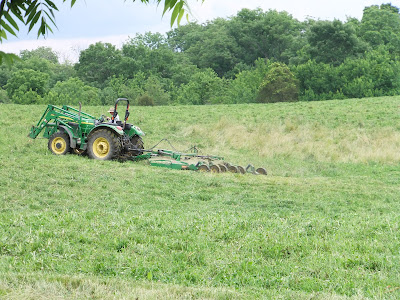While
it may seem like a cow’s diet is straight forward enough (cows eat grass,
right?), dairy cows actually have a very diverse diet and nutritional needs
that require a lot of input from the farmer.
For the peak growing season our cows only get a little supplemental feed
(grain in the parlor and hay to munch on while they wait to be milked). During fall and winter months however these
supplements are much more important.
Mineral/
Salt Blocks – Cows get most of their nutritional needs from their feed, but
just like us there are some things they don’t get enough of. Instead of giving the cows multi-vitamins, we
leave out salt and mineral blocks for the to lick on. Cows are very good at ‘self-diagnosing’, if
they need a particular nutrient, they usually crave it and seek it out. Salt and mineral blocks contain the nutrients
cows most often need extra of or that they don’t usually get from their feed
(often micronutrients like zinc). We
have these in every pasture and the girls take advantage of them as
needed.
Seaweed
– Dried seaweed is actually very high in mineral content and we supply this to
our cows as an alternative to the mineral blocks. It is loose and resembles dried herbs. The cows find it particularly tasty in the
summer!
Dry
hay – Dry hay is very important to our cows diet during the fall and winter
months when grass is dwindling or non-existent.
We mow fields that have specific mixes of grass and legumes which we
know make high quality hay. Once mowed
this hay air dries, is raked into windrows and then baled (usually into large
round bales). Our girls eat this in the
winter as a replacement for grass.
Baleage
– Very similar to silage expect using hay bales! We cut and rake the hay as usual, but we
don’t let it dry out all the way like we would for dry hay. The remaining moisture allows the hay to
ferment. Once baled into big bales we
wrap the bales in plastic, sealing in the moisture and sealing out the
air. After a month or so this is ready
for cow consumption. The only difference
between baleage and haylage is that baleage is made from hay that has been
baled while haylage is loose hay. The
cows love this stuff!
Silage
– Silage is fermented corn. Unlike shell
corn (which just uses the grain of corn taken off the cob), silage uses the
whole stalk, leaves, cob and all. All of
this is coarsely ground and then fermented in tall, round buildings called
silos. This process helps to break down
the fibrous content of the corn stalks so they are easily digested by the cow,
it also adds more roughage to her diet than just plain corn would. The cows love the high moisture content,
especially during the hot summer months.
Shell
corn – Field corn is allowed to dry on the stalk. We then take a machine called a combine
through the field that strips the corn cobs off the stalk. Once off the stalk the corn is shelled, which
means the dry kernels are separated from the cob.
Ground
feed – This is simply grain (from any source but most often corn) ground into a
coarse powder similar to the texture of whole wheat flour or corn meal. If using corn it can be left on the cob or
shelled before grinding. Sometimes corn
and soybeans are combined during the grinding process. Our girls get individual portions of ground
feed while in the milking parlor.
TMR
– TMR stands for Total Mixed Ration.
While we don’t have the equipment for this here at Brickhouse, many
dairies use this to mix grain with hay or silage so the cows get all their feed
in one place. This helps when you are
feeding lots of cows at one time in long bunks.
If you put out the plain grain some cows would get more than their
share. It helps slow the cows down as
they eat and ensures they get enough roughage to balance the concentrated
nutrients in the corn.
Beans
- Typically farmers are referring to soybeans when they talk about beans. Beans add protein and energy to feed rations,
soybean hulls are a great source of fiber!
Watch
out for the next post about the making of baleage!















